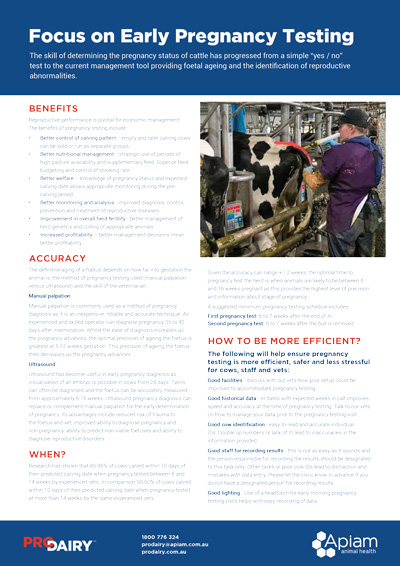The skill of determining the pregnancy status of cattle has progressed from a simple “yes / no” test to the current management tool providing foetal ageing and the identification of reproductive abnormalities.
BENEFITS
Reproductive performance is pivotal for economic management.
The benefits of pregnancy testing include:
- Better control of calving pattern – empty and later calving cows can be sold or run as separate groups.
- Better nutritional management – strategic use of periods of high pasture availability and supplementary feed. Superior feed budgeting and control of stocking rate.
- Better welfare – knowledge of pregnancy status and expected calving date allows appropriate monitoring during the precalving period.
- Better monitoring and analysis – improved diagnosis, control, prevention and treatment of reproductive diseases.
- Improvement in overall herd fertility – better management of herd genetics and culling of appropriate animals.
- Increased profitability – better management decisions mean better profitability.
ACCURACY
The definitive aging of a foetus depends on how far into gestation the animal is, the method of pregnancy testing used (manual palpation versus ultrasound) and the skill of the veterinarian.
Manual palpation
Manual palpation is commonly used as a method of pregnancy diagnosis as it is an inexpensive, reliable and accurate technique. An experienced and skilled operator can diagnose pregnancy 35 to 42 days after insemination. Whilst the ease of diagnosis increases as the pregnancy advances, the optimal precision of ageing the foetus is greatest at 5-12 weeks gestation. This precision of ageing the foetus then decreases as the pregnancy advances.
Ultrasound
Ultrasound has become useful in early pregnancy diagnosis as visualisation of an embryo is possible in cows from 28 days. Twins can often be diagnosed and the foetus can be accurately measured from approximately 6-16 weeks. Ultrasound pregnancy diagnosis can replace or complement manual palpation for the early determination of pregnancy. Its advantages include reduced risk of trauma to the foetus and vet, improved ability to diagnose pregnancy and non-pregnancy, ability to predict non-viable foetuses and ability to diagnose reproductive disorders.

WHEN?
Research has shown that 85-95% of cows calved within 10 days of their predicted calving date when pregnancy tested between 8 and 14 weeks by experienced vets. In comparison 50-60% of cows calved within 10 days of their predicted calving date when pregnancy tested at more than 14 weeks by the same experienced vets.
Given the accuracy can range +/- 2 weeks, the optimal time to pregnancy test the herd is when animals are likely to be between 6
and 16 weeks pregnant as this provides the highest level of precision and information about stage of pregnancy.
A suggested minimum pregnancy testing schedule includes:
First pregnancy test: 6 to 7 weeks after the end of AI
Second pregnancy test: 6 to 7 weeks after the bull is removed
HOW TO BE MORE EFFICIENT?
The following will help ensure pregnancy testing is more efficient, safer and less stressful for cows, staff and vets:
- Good facilities – discuss with our vets how your setup could be improved to accommodate pregnancy testing.
- Good historical data – AI dates with expected weeks in calf improves speed and accuracy at the time of pregnancy testing. Talk to our vets on how to manage your data prior to the pregnancy testing visit.
- Good cow identification – easy to read and accurate individual IDs. Double up numbers or lack of ID lead to inaccuracies in the information provided.
- Good staff for recording results – this is not as easy as it sounds and the person responsible for recording the results should be designated to this task only. Other tasks or poor cow IDs lead to distraction and mistakes with data entry. Please let the clinic know in advance if you do not have a designated person for recording results.
- Good lighting – Use of a headtorch for early morning pregnancy testing visits helps with easy recording of data.
